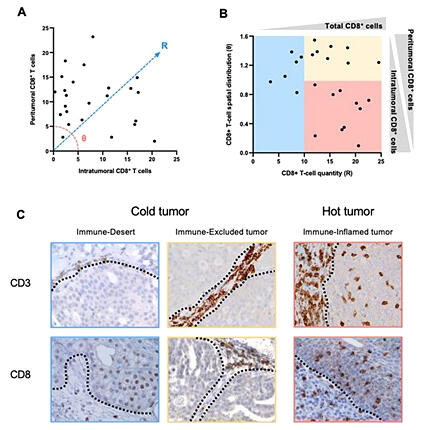Since long ago, dogs have been living together with humans as our companions. According to a recent study, dogs and humans can help each other in cancer research. A research group led by Project Lecturer Daiki Kato of the Graduate School of Agricultural and Life Sciences at the University of Tokyo, and Associate Professor Kohei Saeki of the Department of Veterinary Medicine at Okayama University of Science, analyzed the infiltration of immune cells in canine bladder cancer tissues. The research group found that, similar to human tumors, there were two tumor states: the "hot tumor" state with high T cell infiltration and the "cold tumor" state with low T cell infiltration. Furthermore, they found that "cold tumors" can be classified into "immune-excluded tumors," in which T cells remain in the tumor stroma, and "immune-desert tumors," in which T cell infiltration is poor. These tumor immune phenotypes have been observed in a variety of human tumors. This is the first study in the world to show that a similar classification system can be used for canine tumors. This discovery will dramatically advance cancer immunology research on canine tumors, which had been lagging, and will demonstrate the relevance of the findings of canine tumor research to human tumors.

(A) Quantification of CD8+ T-cell infiltration in the intratumoural and peritumoural regions. The R-score is defined as square root [(intratumoural CD8)2 + (peritumoural CD8)2], and the θ-score is defined as atan (peritumoural CD8/intratumoural CD8).
(B) Scatter plot with R-score representing the quantity of CD8+ T cells on the X-axis and θ-score representing the spatial distribution of CD8+ T cells on the Y-axis. Cut-off values are set at θ = 1.0 and R = 10 to classify the TIME into three categories: Blue for immune desert, yellow for immune excluded and red for immune inflamed.
(C) Representative histologic images showing immune-desert, immune-excluded and immune-inflamed classifications based on the number and distribution of CD3 and CD8+ T cells. Dotted lines delineate the boundaries between intratumoural and peritumoural areas. Images were captured at high-power field (HPF, 400 ×) magnification. DAB was used as the chromogen, and haematoxylin was used as the counterstain.
Provided by the University of Tokyo
Moreover, the research group assessed factors associated with immune cell infiltration and it was noted that the T cell infiltration increased in dogs treated with cyclooxygenase (COX) inhibitors, which are nonsteroidal anti-inflammatory drugs. Based on this finding, they analyzed publicly available gene expression data from canine and human tumor patient-derived samples and found that membrane-bound prostaglandin E2 synthase-2 (mPGES-2), a downstream enzyme of the COX cascade, may be a new therapeutic target for cancer immunotherapy shared by dogs and humans.
Malignancy is a major cause of mortality not only in humans but also in dogs. In the field of medicine, cancer immunotherapy, including treatment with immune checkpoint inhibitors, has become the standard of care and has achieved unprecedented treatment results. With the development of cancer immunotherapy, the immune environment surrounding tumor cells (tumor immune microenvironment) has become crucial in selecting new treatment alternatives and predicting prognosis. However, there is a paucity of studies analyzing the tumor immune microenvironment in canine tumors, and the details were not fully elucidated.
In addition to identifying a new cross-species target for cancer therapy, this study demonstrated that canine tumors have an important role in medical and veterinary cancer research as tumor research models that resemble human tumors. This study was published in Veterinary and Comparative Oncology.
Journal Information
Publication: Veterinary and Comparative Oncology
Title: Comprehensive Analysis of the Tumour Immune Microenvironment in Canine Urothelial Carcinoma Reveals Immunosuppressive Mechanisms Induced by the COX-Prostanoid Cascade
DOI: 10.1111/vco.12999
This article has been translated by JST with permission from The Science News Ltd. (https://sci-news.co.jp/). Unauthorized reproduction of the article and photographs is prohibited.




